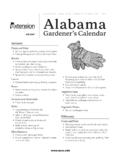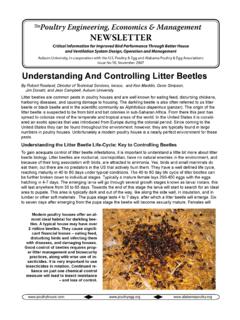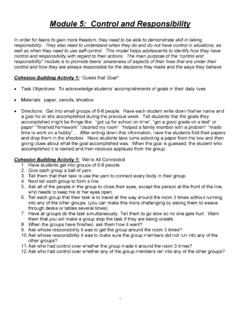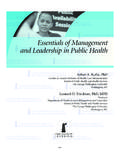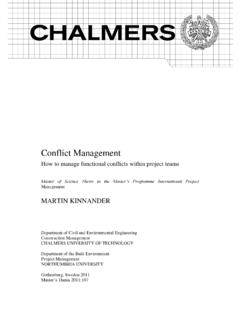Transcription of Module 2: Conflict Management - ACES.edu
1 Module 2: Conflict Management Conflict Management , like effective communication skills, is another important element of social competency. This Module promotes the use of several forms of Conflict Management such as negotiation and self-control. This Module helps to educate the students about ways to communicate effectively when trying to resolve a Conflict and/or reach a compromise. Cohesion Building Activity 1: Review of Communication Observations Facilitators take 5 minutes to ask students to share their experiences of observing how people communicate in daily interactions. Cohesion Building Activity 2: Blind Drawing Activity Task Objectives: Listening and communicating, reading verbal and nonverbal cues, cooperation Materials: 2-4 simple, pre-drawn pictures for each group (see attached samples); paper and pencils Directions: Facilitator says: Listening and communicating can sometimes be frustrating. Each and every day, it seems as though someone is giving us directions or information that we need to pay attention to, using verbal and nonverbal cues.
2 Facilitators decide whether to divide the class into three groups or to do this with the full class. After handing each student 3 pieces of paper, the facilitator says: One student will be the explainer and will hold a picture in his or her hand and will give directions to the other students, the drawers , about how to draw the picture as accurately as possible. None of you who are drawing the picture gets to see it, only the person who is explaining it gets to look at the picture. The drawers also have to turn their backs to the explainer, while drawing the picture. That is, the explainer only gets to use his or her voice (with no body language or facial expressions) to explain what the picture looks like. You may not ask the explainer any questions. Before one of you gets to be the explainer, I will give a brief example of how this will work. I am going to describe the picture I am looking at and I want all of you to draw it. I cannot tell you what it is you are drawing, I.
3 Can only describe the shapes of the objects in the drawing and tell you where to place them on the page. Don't worry if you get frustrated or don't understand everything I. say, just do the best you can. Most people find this hard to do. Select a student or facilitator to be the first describer and select another facilitator be the time-keeper and permit 5. minutes for describing the picture. The first describer reads the information below to the drawers (see page 5 for the picture): 1. Place your pencil in the very center of your paper and without writing on the paper, move you pencil down about a half and inch. Now draw a circle that is slightly smaller than the size of a tennis ball. 2. The circle you have just drawn looks like it is inside an upside down V or a tent. Go ahead and draw the upside down v so that the left and right sides of 1. the circle touch the left and right sides of the upside down V . At the end of each side of the upside down V is a short line.
4 On the left side of the upside down V the short line goes to the left and it is about a half inch long. On the right side of the upside down V is a line that goes to the right about half an inch. It sort of looks like an upside down V with feet. 3. Put your pencil in the middle of the circle without writing in it and move the pencil down until you are about 2/3 down the circle. Here drawn a horizontal line (that goes left to right that is one inch in length. 4. Move your pencil above the line until you are in the top third of the circle and make two small circles side by side that are about the size of a dime. The circles should have about a half an inch space between them. 5. Put your pencil at the top of the large circle you drew (the one you drew first that is a little smaller than a tennis ball) and draw a line straight up that is about 3 inches long. This line should pass through the middle of the upside down V you drew. 6. At the top point of the line you just drew is a V (that is right side up).)
5 This V is about a third of the size of the upside down V that you drew. On the ends of this V , there are small lines like the ones that you drew for the upside down V. On the left side of the V the short line goes to the left and it is about a half inch long. On the right side of the V is a line that goes to the right about half an inch. We are finished. Let's compare what you drew with the picture I was describing. After students compare their drawings with the picture, ask students to say how easy or hard the task was for them and what made it easy or hard. Next, tell them they are going to draw two more pictures that two more of the students will describe and then we will discuss the activity in more detail. Pick a student to be the explainer and give him or her the first picture, set a time limit ( , you have 5 minutes ) and tell the explainer to begin describing the picture to the drawers.. When time is up, have the explainer show the group the picture and have members compare how they did.
6 Ask students to say how easy or hard the task was for them (get a hand showing for: very easy, some what easy, somewhat hard, very hard). Select a different person to be the explainer. The facilitator says This time the explainer . and drawers will face each other. The explainer will use his or her voice, as well as facial expressions and gestures to describe the picture. The explainer also can answer your questions Give the explainer the second picture, set a time limit ( , you have 5. minutes ) and tell the explainer to begin describing the picture to the drawers.. When time is up, have the explainer show the group the picture and have members compare how they did. Ask drawers: Was it any easier this time to draw the picture? If so, what made it easier? Go to Process Questions on page 3. 2. PROCESS QUESTIONS: 1. What was the most frustrating part of doing this activity? 2. What helped you as the explainer to do the best job describing the picture? 3. What helped you as the drawer to understand what you needed to draw?
7 4. What did you do when you were having difficulty explaining the picture? 5. What did you do when you had difficulty understanding what to draw? 6. In real life when you do not understand what someone is telling you, how do you react to that situation? What are things you do to understand them better? 7. Why is it important to take the time to understand what someone is trying to tell you? 8. What do you do when you are trying to tell someone something and they do not seem to understand you? 9. Why is it important to take the time to explain something important to someone when at first they do not understand what you mean? Point out that feeling frustrated is natural. Finding ways to understand what a person means or to be understood if you are the person talking can help to reduce frustration and Conflict that can result when people are not understanding each other. See additional process questions below. Encourage the group to discuss the differences in communication that were used, the effectiveness of one type of communication over another, and conclusions about what good communication really is.
8 CENTRAL ACTIVITY: Negotiation Game Task Objectives: learning how to discuss and negotiate as a means of reaching a compromise; learning how to see and respect another person/groups' point of view. The ultimate goal is learning to work together to negotiate a solution ( , reach a compromise) that both parents and teens think is acceptable and fair. Materials: flip chart and markers; can make signs that say things like: good job too aggressive slow down take turns for jury to hold up during the negotiation Directions: Step 1: Have the students form two groups (the parent group and the teen group pick an age for the teen group that is 1-2 years younger than the students, , 14 years old). Select a topic: teen drinking alcohol, teen smoking, curfew, teens' style of dress, teen's amount of (unsupervised) time with friends, teens'. educational activities (both during school and at home), teen responsibilities ( chores, conduct, effort in school) and teen freedoms (unsupervised time with friends, dating, weekend activities with friends, (can include other topics suggested by the group).)
9 Explain that the group will be engaging in collaborative problem solving as the play the negotiation game. Collaborative problem solving involves six important steps: Step 1: Establish ground rules Step 2: Reach mutual understanding Step 3: Brainstorm Step 4: Agree to one or more solutions Step 5: Write down your agreement Step 6: Set a time for a follow-up discussion to evaluate your progress Explain to all the participants that ground rules must be established first, such as: no yelling, listen without interrupting Have the students make a list of 3-4 ground rules to ensure everyone will be able to work together. Post the ground rules on the wall for all to see (step 1: ground rules). 3. Next, have all participants agree that they are there to work out the problem they have selected (step 2: mutual understanding about the problem to be solved). Third, have the teen and parent groups move to different parts of the room and have each group brainstorm (step 3) all possible solutions to the problem (remind the group playing parents, that they need to take their parents' perspectives; remind the teen group to remember back to when they were fourteen or fifteen.)
10 And how they felt about the issue). Have each group select 2 participants to play the jury. The jury will watch the parent and teen group discuss ways to solve the problem and will evaluate how well the process goes. Give the jury signs that say: slow down speak louder take turns be calm good job (add other signs as needed). The jury will hold up these signs as the negotiation process is occurring. The parent and teen group members should be asked to heed the jury's signs. Bring the groups together and move to Step 4 the negotiation process : Have the group review the list of possible solutions that the teen and parent groups generated. Have them discuss the pros and cons of the solutions. Mark out solutions that both groups say will not work. Have the group keep working until they arrive at one or more solutions to the problem that both think will work. To finish the negotiation, write down the agreed upon solution and agree on a time frame for testing out the solution (steps 5 & 6).
